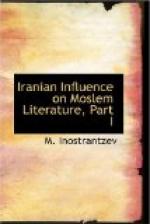[Sidenote: Man in embryo: his torments till and after death.]
[Sidenote: Tribulations of human existence.]
When the liquid, of which the perfect child is to be built, enters the uterus of the woman, and mixes itself with her liquid substance and her blood it becomes thick and pulpy. Next the liquid is stirred by a wind and becomes like sour milk and later on hard like curdled milk. After a certain number of days the individual members become separate. If it is a man child its face is turned to the back of the mother; if it is a female it is turned towards the belly. In the foetus the hands are on the cheeks and the chin is on the knee. It is all bundled up in the foetus as if it was thrust into a pouch. It breathes through a narrow opening. Each member is bound by a chord. Above it is the heat and the pressure of the mother’s womb; below are darkness and constriction. It is tied with a piece of its navel to that of its mother, sucks through it and lives upon her food and drink. In this position it remains in gloom and confinement till the day of birth. When that day comes a wind acquires control of the womb, that child acquires strength to rise, turns the head towards the opening and experiences in this confinement the pain of one forced into a distressing torture. Should it fall to the ground or be touched only by a breath of wind or should it come in contact with one’s hands it feels greater pain, than a person that is flayed alive. The new born babe then suffers all manner of torment. When it is hungry it cannot ask for food; thirsty, for drink; when in pain it cannot call for help. Besides it is lifted up, laid down, wrapped up, swathed, washed and rubbed. When it is laid to sleep on the back it cannot turn. Again so long as it is given the suck it is subjected to all manner of other tortures. When it is finally delivered from these, it is liable to those of education and has then to suffer a great deal, the brusqueness of the




